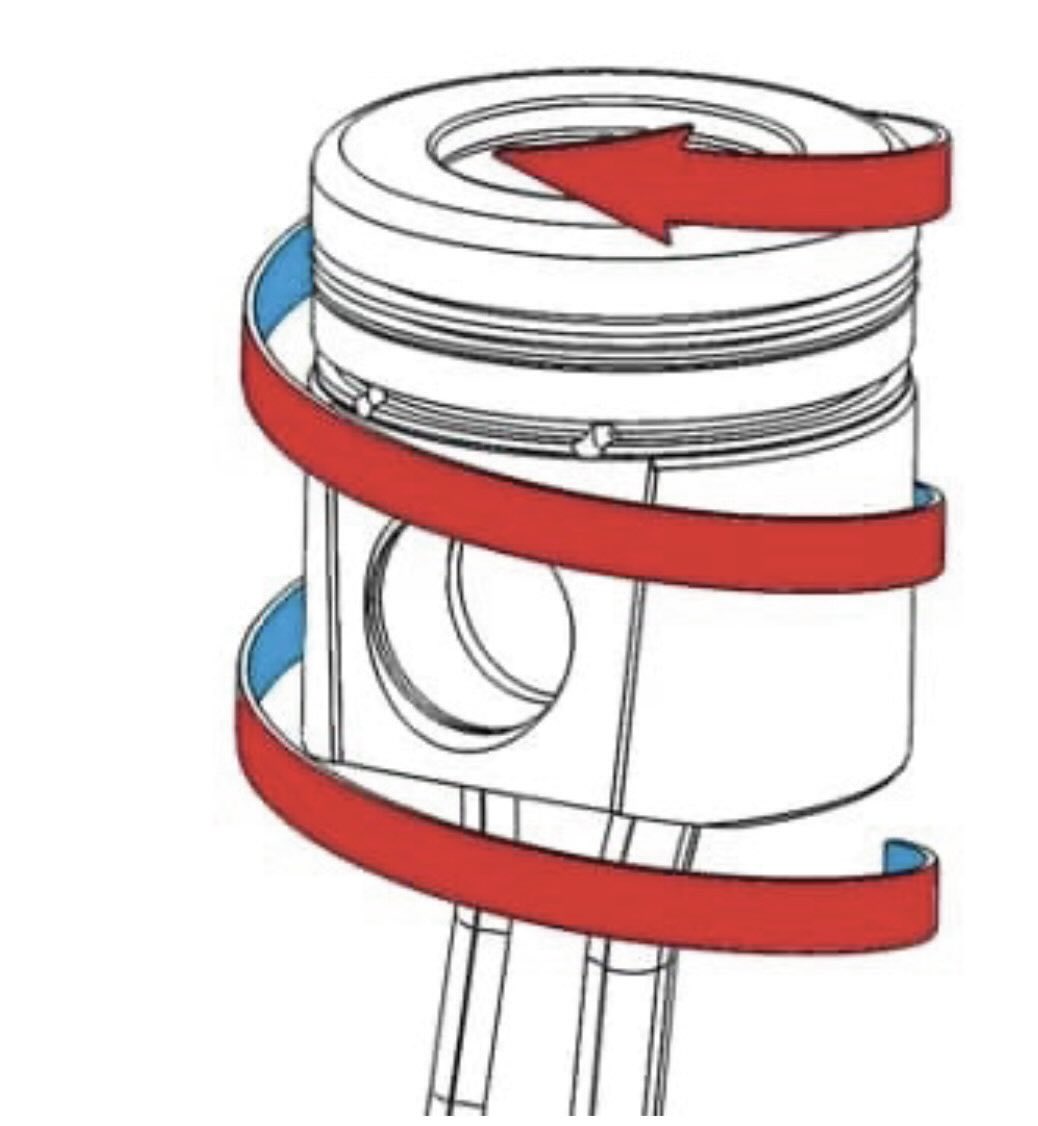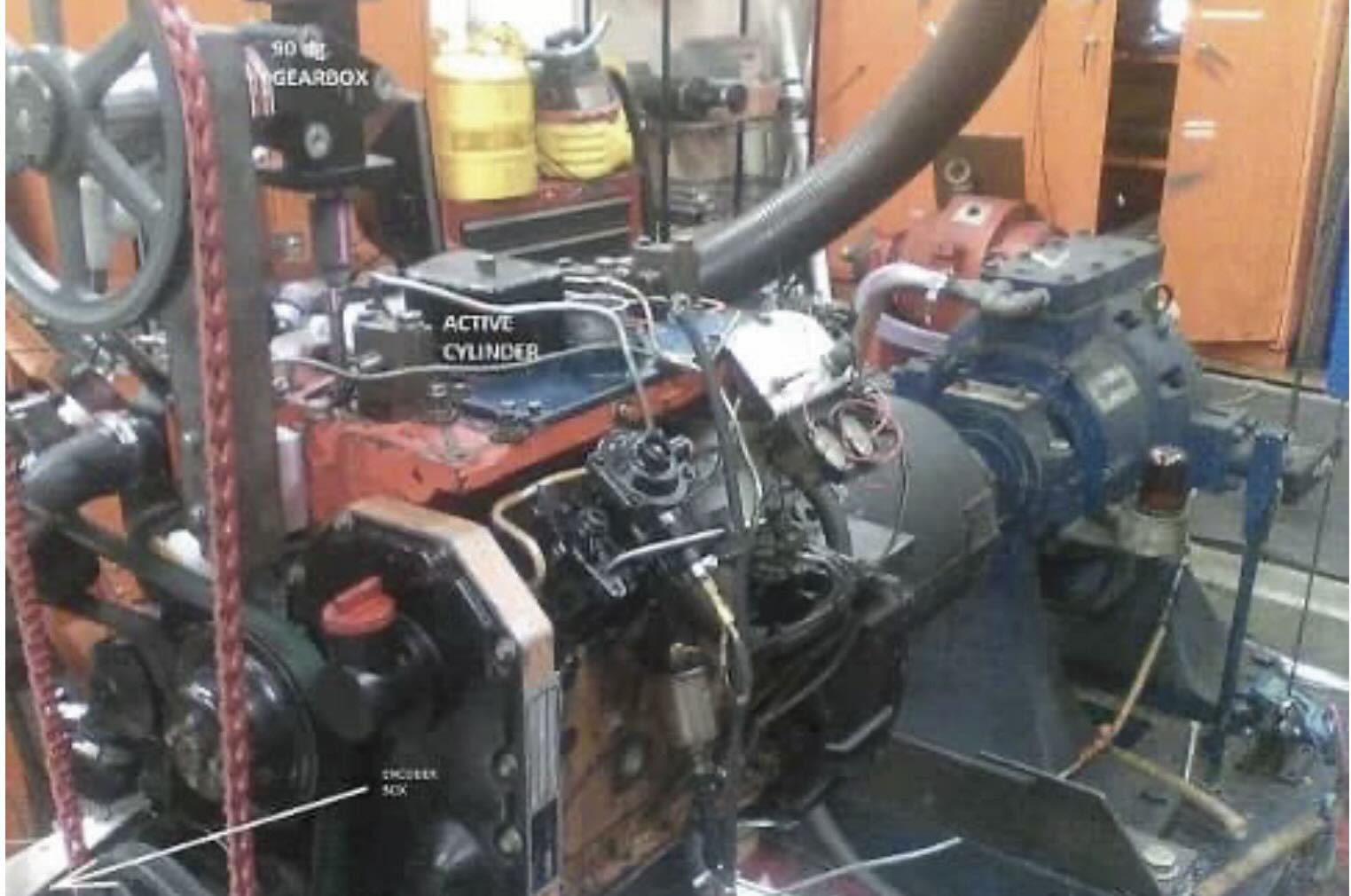HIGHLIGHTS
•
In a comparison of the performance of a conventional diesel engine versus a rotating liner engine (RLE), the latter exhibited a friction mean effective pressure that was 0.38 bar lower at a temperature of approximately 70°C and 800 rpm idle.
•
When the operating conditions were increased to 1,150 rpm and under 7 bar of indicated mean effective pressure, the friction mean effective pressure of the RLE was reduce by 0.70-0.80 bar relative to the baseline engine.
•
This result may be due to the following two factors in the RLE: a fairly thick oil film between the liner and the block, and the liner rotation
Various approaches have been taken to improve the fuel economy of internal combustion engines. One strategy that has been under evaluation is a design concept known as the rotating liner engine (RLE). In a previous TLT article,
1 an initial discussion was held about the RLE and data generated to evaluate its performance. The RLE was developed to address the main source of friction in a conventional diesel engine which is found in the piston assembly. By enabling the cylinder liner to rotate, metallic contacts among components in the piston assembly are minimized leading to a reduction in localized friction by a factor of 100 and lower wear.
An image of the RLE is shown in Figure 5. The cylinder liner rotates at a surface speed of 2-4 meters per second.
 Figure 5. An image of a new type of heavy-duty diesel engine, known as the rotating liner engine (RLE), involves the cylinder liner rotating at a surface speed of 2-4 meters per second. Figure courtesy of Tribo Dynamics.
Figure 5. An image of a new type of heavy-duty diesel engine, known as the rotating liner engine (RLE), involves the cylinder liner rotating at a surface speed of 2-4 meters per second. Figure courtesy of Tribo Dynamics.
Initial testing was conducted using one cylinder (#2) in a four-cylinder Cummins 4BT diesel engine. A baseline diesel engine was used for comparison purposes. Both engines used a 15W-40 lubricant and were maintained at 70°C. The RLE demonstrated a 32% reduction in fuel consumption compared to the conventional diesel engine in this study. When extrapolated to a four-cylinder engine, the researchers calculated that the RLE produced a 40%+ reduction in friction compared to the baseline engine.
Dr. Dimitrios Dardalis, chief technology officer for Tribo Dynamics in Austin, Texas, led the initial work and indicated that the objective of the next phase of research is to conduct more extensive work with the baseline engine in comparison testing with the RLE. He says, “In our initial studies, we did not produce a detailed evaluation of the performance of the baseline engine. This phase of work involved directly comparing the performance of a one-cylinder baseline engine versus a one-cylinder RLE. In both cases the only active cylinder is cylinder #2. Our objective was to determine the friction mean effective pressure of both engines which is a measure of the total friction generated per cycle per unit volume.”
Friction mean effective pressure is the difference between the indicated mean effective pressure and the brake mean effective pressure. The former is a measurement of the work produced by the combustion gas per cycle, and the latter is the work per cycle that actually reached the dynamometer. From this result, Dardalis and his colleagues determined the fuel economy difference between the RLE and the baseline engines.
Dardalis says, “The indicated mean effective pressure is a thermodynamic parameter that was originally developed to evaluate the performance of steam engines which generate little friction due to their low operating pressure. Brake mean effective pressure is the torque per unit of piston displacement exerted by the engine as measured by a dynamometer.”
Friction mean effective pressure of RLE under load
The lubricant used in this test was a 15W-40, which Dardalis considers the standard viscosity grade, which is a good compromise between low-load/high-rpm and high-load/low-rpm (the former generally requires a lower viscosity to reduce bearing friction, the later requires high viscosity to reduce piston boundary friction). The temperature of both engines is raised to approximately 60°C through the use of a heater and a pump that enables the lubricant to move through a heat exchanger. Once this temperature is reached, the engines are started and operated under various speeds and loads until the temperature reaches 68°C.
Both engines are then loaded and the data is collected. Testing is terminated when the temperature in the lubricant sump reaches 71°C-74°C. The RLE prototype is shown in Figure 6. These temperatures represent the low end of a typical operating temperature, and they are chosen because it is difficult to warm up a 4-cylinder block when only one cylinder operates.
 Figure 6. A prototype of the RLE with a single cylinder demonstrated lower friction mean effective pressure when evaluated versus a conventional diesel engine. Figure courtesy of Tribo Dynamics
Figure 6. A prototype of the RLE with a single cylinder demonstrated lower friction mean effective pressure when evaluated versus a conventional diesel engine. Figure courtesy of Tribo Dynamics
In evaluating the RLE test results, Dardalis noted that this engine required a longer warm up time than the baseline engine. He says, “This effect can only be explained by the lower friction generated by the RLE resulting in a lower degree of heat dissipation into the oil (via the piston oil cooling jet) and the coolant (via the liner). Significantly lower carbon dioxide emissions at idle further explain this result.”
The researchers found that the friction mean effective pressure at a coolant and lubricant temperature of approximately 70°C and 800 rpm idle was 1.62 bar, which is 0.38 bar less than the baseline engine. Dardalis says, “When the speed of both engines was increased to 1,150 ppm, and under a 7-bar indicated mean effective pressure (which corresponds to about one-third load), the friction mean effective pressure of the RLE is reduced by 0.70-0.80 bar relative to the baseline engine at 7 bar of indicated mean effective pressure.”
Two reasons for this phenomenon may be due to the oil film between the liner and the block is fairly thick leading to reduced friction and the liner rotation could increase the minimum film thickness in the piston skirt and especially in the piston rings, eliminating metallic contact and boundary friction, which will reduce the friction coefficient by a factor of up to 100.
The reduced friction achieved with the RLE compared to the baseline engine was even evident when the lubricant viscosity of the latter was reduced from 15W-40 to 10W-30. Dardalis says, “We observed a significant reduction in friction mean effective pressure at idle but not under load for the baseline engine. This effect is due to the increased boundary friction of the 10W-30 lubricant under load that offsets the lower viscosity.”
The frictional behavior of the two converted single cylinder engines is of course different from a complete engine. However, relatively simple calculations by using published friction data on crankshaft and piston assembly friction were used to interpret the data for a complete engine. Applying the data collected from the test results, the researchers determined that the potential fuel economy benefit for a complete 4-cylinder RLE was 33% at idle and up to 10% for medium loads and speeds. Extrapolation of the experimental results under full load and medium speed predicts a fuel economy benefit of the order of 7.5%.
Dardalis says, “The next steps in evaluating the benefits of the RLE are to install an external supercharger that will enable testing at levels closer to the indicated mean effective pressure of a modern heavy-duty diesel engine and to build a complete four-cylinder RLE to better understand engine performance over an extended operating time.”
Additional information can be found in a recently published article
2 or by contacting Dardalis at
dardal@rotatingliner.com.
REFERENCES
1.
Canter, N. (2021), “Evaluation of a rotating liner diesel engine,” TLT,
77 (7), pp. 14-15. Available at
www.stle.org/files/TLTArchives/2021/07_July/Tech_Beat_I.aspx.
2.
Dardalis, D., Hall, M., Riley, S., Basu, A. and Matthews, R. (2025), “10% Fuel economy benefit at part load and up to 33% at idle for a diesel engine via reducing friction. Testing the rotating liner engine and an identical baseline under load,”
SAE Technical Paper, 2025-01-8390, To Be Published.